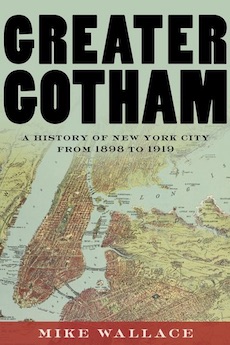Winner of the 2018 Ralph Waldo Emerson Award
By Allen D. Boyer
With his history Gotham: A History of New York City to 1898, Mike Wallace won a Pulitzer Prize for history. Greater Gotham dovetails meticulously with that earlier book. It opens on New Year’s Eve 1897, two hours before midnight, as thousands of New Yorkers gathered to celebrate the creation of the United States’ largest city—a consolidation that would bring together, under a single municipal government, Manhattan, the Bronx, Brooklyn, Queens, and Staten Island.
Two decades later, Wallace notes, “Greater Gotham had gone from being a project on paper to being a fact on the ground. A colossal fact. After twenty years of frenetic building, New York had morphed into a City Gigantic. Everywhere one looked, some component part had bulked up to extraordinary size.” New York was the home of the tallest, the largest, and the biggest—whether one spoke of skyscrapers, Catholic orphanages, corporations, or municipal debt.
Greater Gotham is a bold, broad, effort to write the history of that crucial chapter in New York City history; its ambition and energy rival John Dos Passos and Manhattan Transfer. With 123 pages devoted to references, bibliography, and index, the book will be a godsend for students and scholars. Moreover, with the turn of any page, its 1,052 pages of text repay browsing with revealing examples of the first, biggest, and greatest. For example:
On September 13, 1899, realtor Henry Hale Bliss steps in front of an electric cab carrying a doctor home from a house call, and becomes the city’s first traffic death.
Italian laborers and black muleskinners complete the city water system, bringing water from the Catskills as far south as Staten Island, an engineering masterpiece that rivals the Panama Canal.
Where Broad Street meets Wall Street, the New York Stock Exchange erects a temple of a trading floor, fronted by giant Corinthian columns and a pediment: “on one day in January 1901 an astonishing 2 million shares were traded.”
The Flatiron Building rises; and the Met Life Tower, and the Woolworth Building.
Tiffany’s moves uptown from Union Square, renting out its old building to needle-trade firms.
A poster is issued to campaign workers: “Hearst in War, Hearst in Peace, and Hearst in the Hearts of His Countrymen.”
Visitors in flowing dresses and straw boaters—“rubberneckers,” people begin calling them—board an open-air tourist bus, on a tour that starts from the Flatiron Building.
Vladimir Ilyich Lenin praises the generosity of the New York Public Library, which measures its success by the number of books it makes available to the public.
Two little boys pose by a gate in a cast-iron fence. Each wears a white shirt and newsboy cap and carries an armful of textbooks. They enter history as “Italian Pupil” and “Jewish Pupil.” In 1909, cops take more than 11,000 children into custody, almost half for “trivial violations—flying kites, building bonfires, playing shinny (street hockey), splashing under hydrants.”
Wallace tells the city’s story with capsule biographies, vignettes, and numerous illustrations. The illustrations often catch city life from unexpected angles: Emma Goldman riding a streetcar, the burned-out work floor of the Triangle Shirtwaist Factory, and an Evening Sun cartoon from 1913, brilliantly street-smart and avant-garde: “Seeing New York with a Cubist: The Rude Descending a Staircase (Rush Hour at the Subway).”
“The Guinness Book of World Records approach to describing Gotham’s early-twentieth-century development was an appealing one,” Wallace concludes.
“This prideful self-congratulatory viewpoint was both merited and misleading—accurate in its touting of the parts (biggest this, largest that) but less convincing in its characterization of the whole. . . . It encouraged the assumption that a successful metropolitan order had been wrought out of multi-municipal chaos. Now the city worked. But did it? That depended on which New York you looked at, which New Yorkers you asked, and what criteria for success you applied.”
Wallace has written a book that is more than a compendium of events and records, and he has explained why that question remains eternal.
Allen D. Boyer (ΦBK, Vanderbilt University, 1977), lives and writes in Staten Island, a borough of New York City. Vanderbilt University is home to the Alpha of Tennessee Chapter of Phi Beta Kappa.




